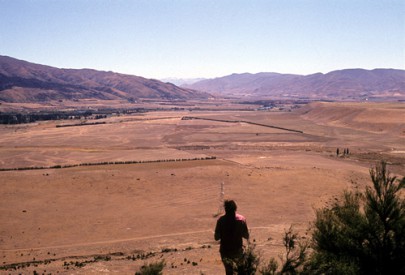Inland outwash gravels
In this section
-
Inland & alpine
- Basic cliffs, scarps and tors
- Boulderfields of acidic rocks (non-volcanic)
- Boulderfields of calcareous rocks
- Boulderfields of quartzose rocks
- Braided riverbeds
- Calcareous cliffs, scarps and tors
- Calcareous screes
- Cliffs, scarps and tors of acidic rocks
- Cliffs, scarps and tors of quartzose rocks
- Cloud forests
- Frost hollows
- Granitic gravel fields
- Granitic sand plains
- Inland outwash gravels
- Inland saline (salt pans)
- Inland sand dunes
- Limestone erosion pavements
- Moraines
- Old tephra (>500 years) plains (= frost flats)
- Recent lava flows
- Sandstone erosion pavements
- Screes of acidic rocks
- Strongly leached terraces and plains
- Ultrabasic boulderfields
- Ultrabasic cliffs, scarps and tors
- Ultrabasic hills
- Ultrabasic screes
- Volcanic boulderfields
- Volcanic debris flows or lahars
- Volcanic dunes
- Young tephra plains and hillslopes

Inland outwash gravels in the upper Clutha Valley (Peter Williams)
Inland outwash gravel plains occur in intermontane basins and are formed on terraces comprising late-Otiran fluvioglacial materials. These materials originated from the meltwater of retreating glaciers of this period. Their coarse substrates (sandy gravels) result in soils that are excessively drained and very low in nutrients, which combined with harsh montane environments creates stressful conditions for plants. The extensive terrace treads have shallow to very stony soils with low clay content (often <12% clay) overlain with very thin (<5cm) layers of topsoil. Local climate conditions result in frost heave and wind erosion. These processes interact with the channel-bar surface patterning created by fluvial processes to produce subtle variation in microtopography, soil moisture and fertility. These surfaces support sparse, undeveloped vegetation. Within and between sites, composition appears to be influenced by a combination of microtopography and large-scale precipitation gradients, with the most distinctive vegetation occurring on the shallowest soils on the driest sites. On the deflated channels frequent species include turfy coprosma (Coprosma petriei), patotara (Leucopogon fraseri), Pimelea spp., Poa. spp., scabweeds (Raoulia spp.), creeping pohuehue (Muehlenbeckia axillaris), and common mountain daisy (Celmisia gracilenta). The distinctive tumbleweed lichen Chondropsis semiviridis is also present. The deeper soils of the convex bars are characterised more by fescue tussock (Festuca novae-zelandiae) and ‘open’ scrub, comprising chiefly matagouri (Discaria toumatou) and porcupine shrub (Melicytus alpinus). Exotic species may be important, particularly on more fertile, deeper soils. In former times, inland outwash gravel plains probably had more extensive and diverse shrub cover, particularly on the deeper soils.
Outwash deposits earlier than the late-Otiran period are often overlain with loess. At locations where wind deflation has removed this loess, the surfaces equate ecologically with the late-Otiran surfaces described above. Later (post-glacial) deposits are higher in nutrients and have more heterogenous soil conditions. As such, they are excluded from this definition.
Synonyms
outwash plain, sandur, sandar
Notable flora and fauna
Threatened plants include the nationally critical Leptinella conjuncta and inland cress (Lepidium solandri); nationally endangered dwarf musk (Mazus novaezeelandiae subsp. impolitus f. impolitus); nationally vulnerable mat broom (Carmichaelia nana), trailing bindweed (Convolvulus verecundus), leafless pohuehue (Muehlenbeckia ephedroides), cushion pimelea (Pimelea sericeovillosa subsp. pulvinaris) and fan-leaved mat daisy (Raoulia monroi); declining dwarf broom (Carmichaelia vexillata) and dwarf heath (Leucopogon nanum).
Threatened fauna include the nationally vulnerable banded dotterel (Charadrius bicinctus) and long-toed skink (Oligosoma longipes), nationally endangered black-fronted tern (Chlidonias albostriatus) and robust grasshopper (Brachaspis robustus), declining green skink (Oligosoma chloronoton) and jewelled gecko (Naultinus gemmeus), and relict spotted skink (Oligosoma lineoocellatum).
Threat status
Critically endangered (Holdaway et al. 2012)
Threats
Weed invasions are a major threat, mainly wilding pines (Pinus spp.), sweet briar (Rosa rubiginosa), broom (Cytisus scoparius), Russell lupin (Lupinus polyphyllus) and stonecrop (Sedum acre). The natural values of this system are being destroyed in particular by viticulture and residential subdivision in Central Otago, and irrigation and cultivation in the upper Waitaki. Sites are susceptible to grazing by stock, rabbits and hares. There is some mining activity in the Nevis Valley and damage by off-road vehicles in some areas.
Where do they occur?
They are best developed in the Mackenzie Basin, Canterbury, the upper Clutha and upper Waitaki basins of Central and North Otago, and also in the Ashburton, Rakaia, Rangitata, and Waimakariri valleys of Canterbury. Smaller areas are found in the foothill valleys of rivers such as the Mataura and Pareora.
Further reading
Peat N, Patrick B 1999. Wild Central: Discovering the natural history of Central Otago. Dunedin, University of Otago Press. Pp. 37-38.
Wardle P 1991. Vegetation of New Zealand. Cambridge University Press. 672 p.
Williams PA 1980 Vittadinia triloba and Rumex acetosella communities in the semi-arid regions of the South Island. New Zealand Journal of Ecology 3: 13-22.


